Advanced Financial Accounting Report: AASB 6 and Asset Recognition
VerifiedAdded on 2023/01/20
|5
|733
|57
Report
AI Summary
This report delves into the specifics of Advanced Financial Accounting, focusing on AASB 6, the standard for Exploration and Evaluation of Mineral Resources. The report defines assets as per AASB 6 and elaborates on the recognition criteria, highlighting the importance of accounting policies and the fulfillment of specific conditions related to the tenure of interest areas and the potential for economic benefits. It then compares and contrasts the definition and recognition criteria of assets under AASB 6 with those of the conceptual framework, emphasizing the consistency in recognizing assets where the organization is likely to gain economic benefits while acknowledging differences in asset definition. The report concludes with a list of references to support the analysis.
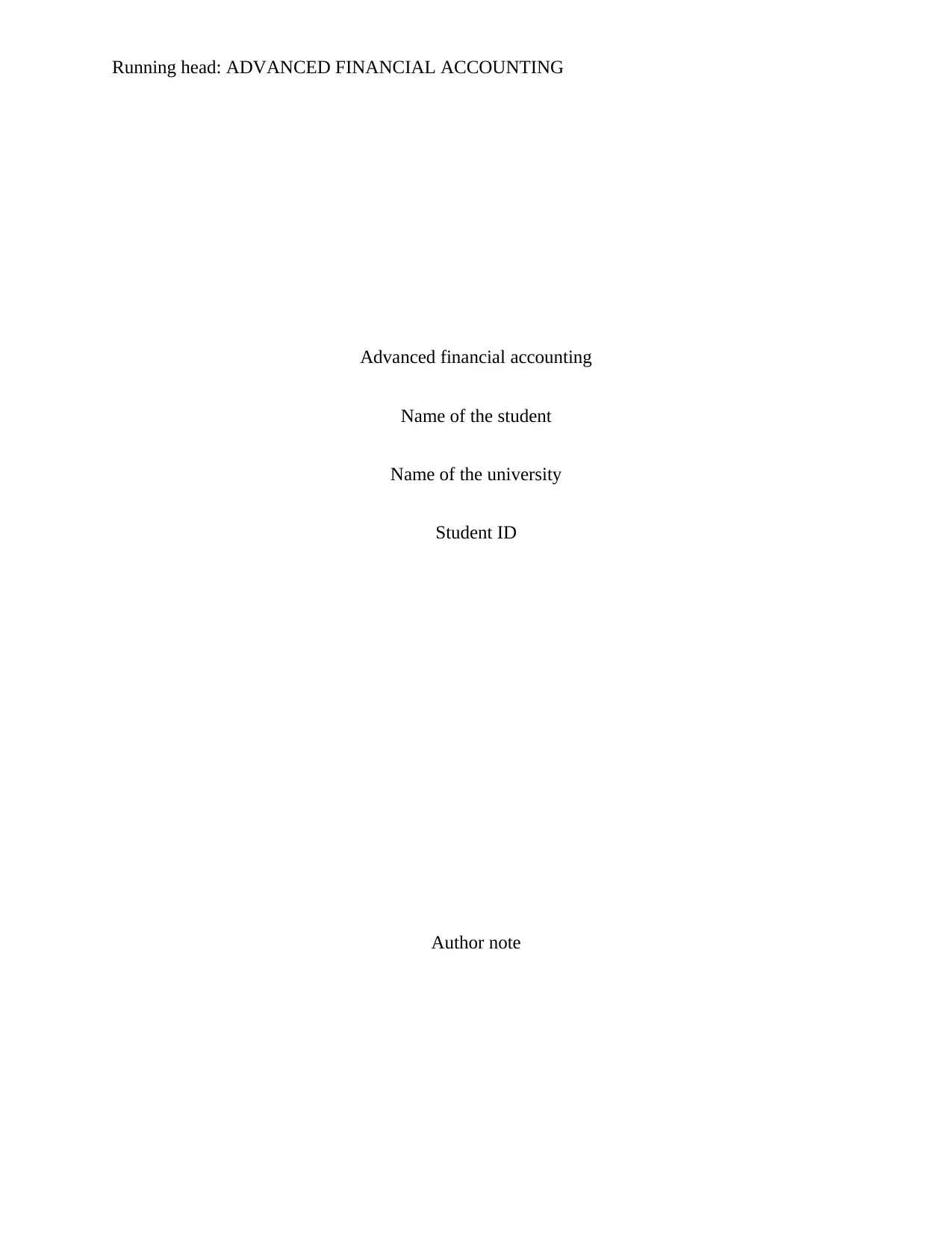
Running head: ADVANCED FINANCIAL ACCOUNTING
Advanced financial accounting
Name of the student
Name of the university
Student ID
Author note
Advanced financial accounting
Name of the student
Name of the university
Student ID
Author note
Paraphrase This Document
Need a fresh take? Get an instant paraphrase of this document with our AI Paraphraser
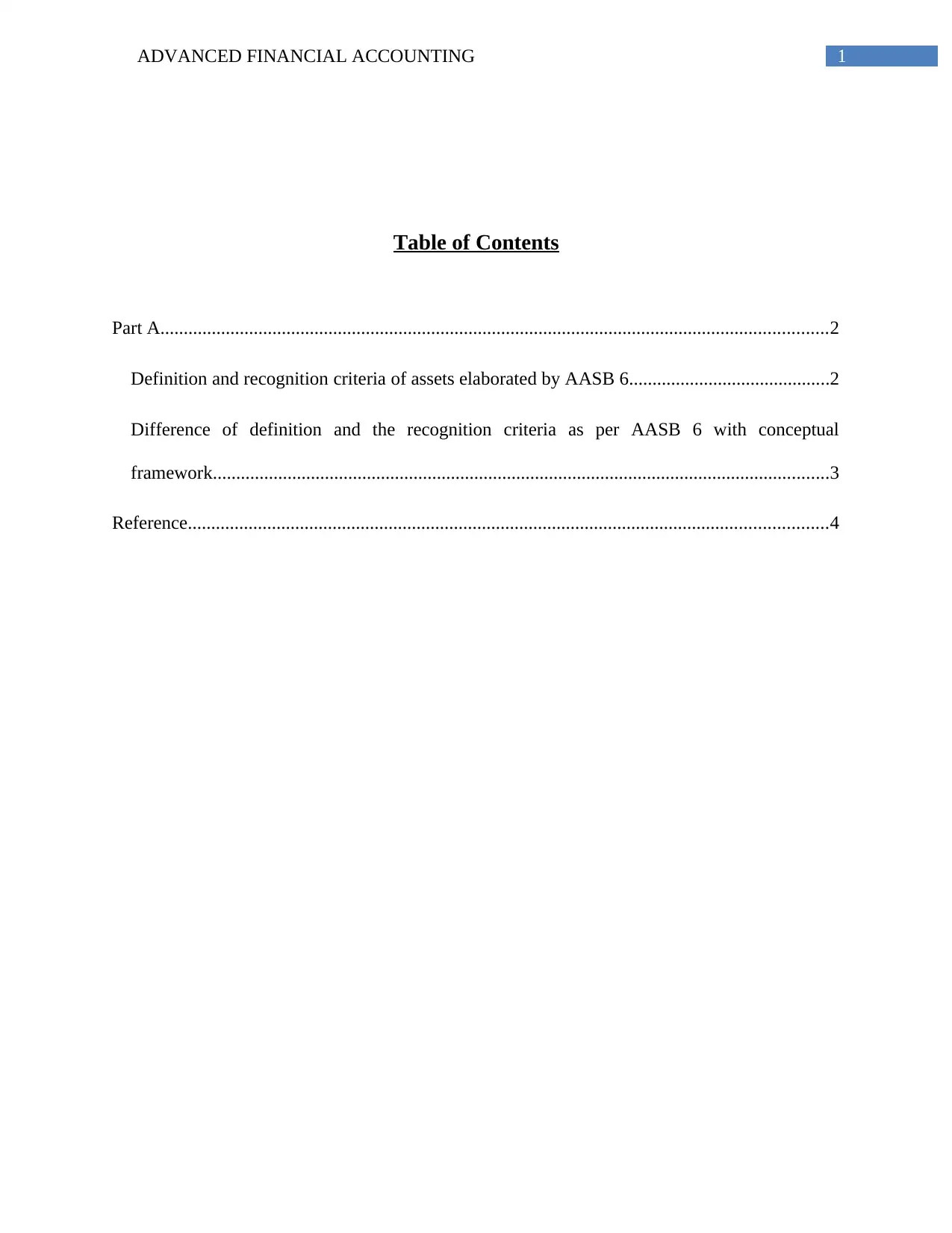
1ADVANCED FINANCIAL ACCOUNTING
Table of Contents
Part A...............................................................................................................................................2
Definition and recognition criteria of assets elaborated by AASB 6...........................................2
Difference of definition and the recognition criteria as per AASB 6 with conceptual
framework....................................................................................................................................3
Reference.........................................................................................................................................4
Table of Contents
Part A...............................................................................................................................................2
Definition and recognition criteria of assets elaborated by AASB 6...........................................2
Difference of definition and the recognition criteria as per AASB 6 with conceptual
framework....................................................................................................................................3
Reference.........................................................................................................................................4
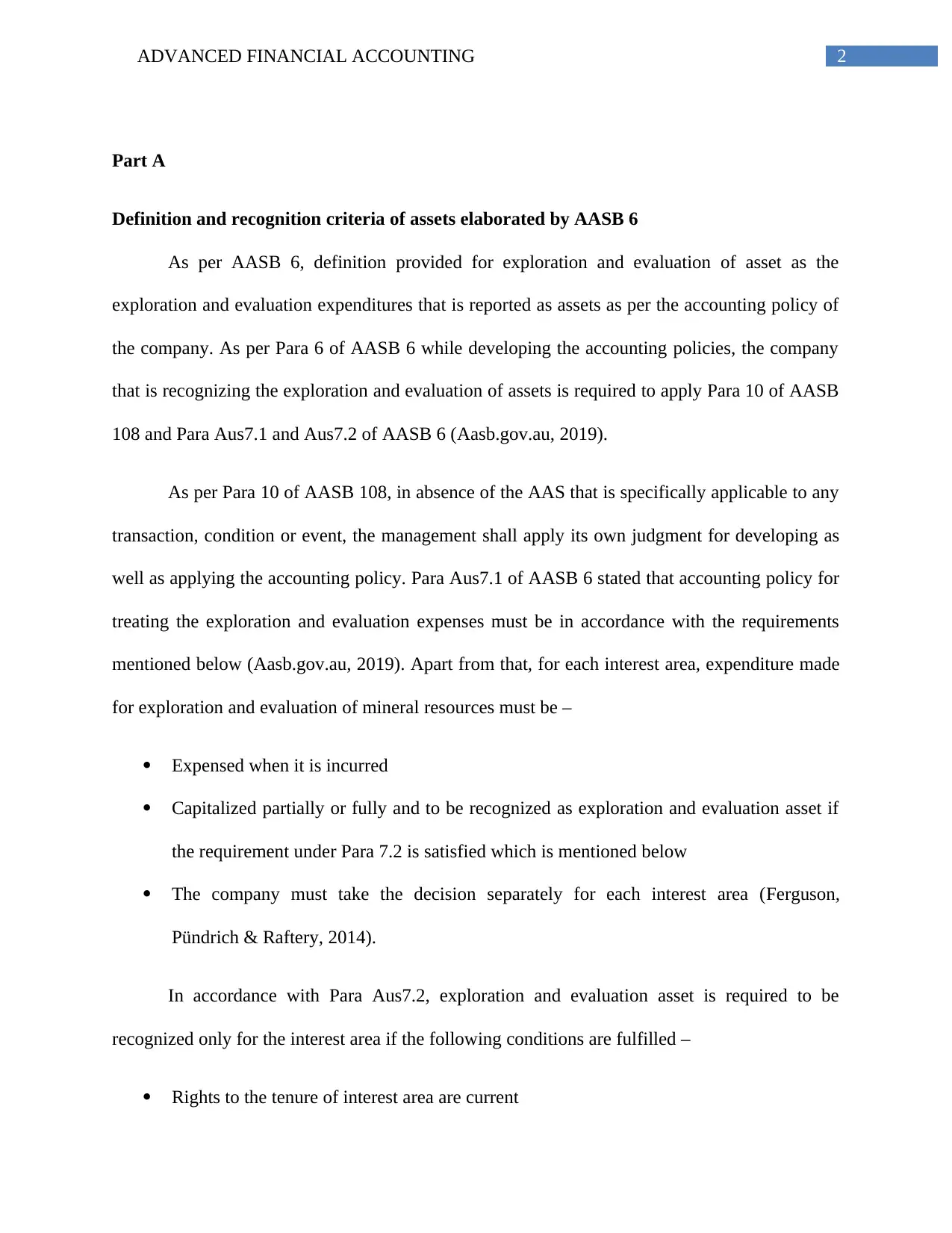
2ADVANCED FINANCIAL ACCOUNTING
Part A
Definition and recognition criteria of assets elaborated by AASB 6
As per AASB 6, definition provided for exploration and evaluation of asset as the
exploration and evaluation expenditures that is reported as assets as per the accounting policy of
the company. As per Para 6 of AASB 6 while developing the accounting policies, the company
that is recognizing the exploration and evaluation of assets is required to apply Para 10 of AASB
108 and Para Aus7.1 and Aus7.2 of AASB 6 (Aasb.gov.au, 2019).
As per Para 10 of AASB 108, in absence of the AAS that is specifically applicable to any
transaction, condition or event, the management shall apply its own judgment for developing as
well as applying the accounting policy. Para Aus7.1 of AASB 6 stated that accounting policy for
treating the exploration and evaluation expenses must be in accordance with the requirements
mentioned below (Aasb.gov.au, 2019). Apart from that, for each interest area, expenditure made
for exploration and evaluation of mineral resources must be –
Expensed when it is incurred
Capitalized partially or fully and to be recognized as exploration and evaluation asset if
the requirement under Para 7.2 is satisfied which is mentioned below
The company must take the decision separately for each interest area (Ferguson,
Pündrich & Raftery, 2014).
In accordance with Para Aus7.2, exploration and evaluation asset is required to be
recognized only for the interest area if the following conditions are fulfilled –
Rights to the tenure of interest area are current
Part A
Definition and recognition criteria of assets elaborated by AASB 6
As per AASB 6, definition provided for exploration and evaluation of asset as the
exploration and evaluation expenditures that is reported as assets as per the accounting policy of
the company. As per Para 6 of AASB 6 while developing the accounting policies, the company
that is recognizing the exploration and evaluation of assets is required to apply Para 10 of AASB
108 and Para Aus7.1 and Aus7.2 of AASB 6 (Aasb.gov.au, 2019).
As per Para 10 of AASB 108, in absence of the AAS that is specifically applicable to any
transaction, condition or event, the management shall apply its own judgment for developing as
well as applying the accounting policy. Para Aus7.1 of AASB 6 stated that accounting policy for
treating the exploration and evaluation expenses must be in accordance with the requirements
mentioned below (Aasb.gov.au, 2019). Apart from that, for each interest area, expenditure made
for exploration and evaluation of mineral resources must be –
Expensed when it is incurred
Capitalized partially or fully and to be recognized as exploration and evaluation asset if
the requirement under Para 7.2 is satisfied which is mentioned below
The company must take the decision separately for each interest area (Ferguson,
Pündrich & Raftery, 2014).
In accordance with Para Aus7.2, exploration and evaluation asset is required to be
recognized only for the interest area if the following conditions are fulfilled –
Rights to the tenure of interest area are current
⊘ This is a preview!⊘
Do you want full access?
Subscribe today to unlock all pages.

Trusted by 1+ million students worldwide
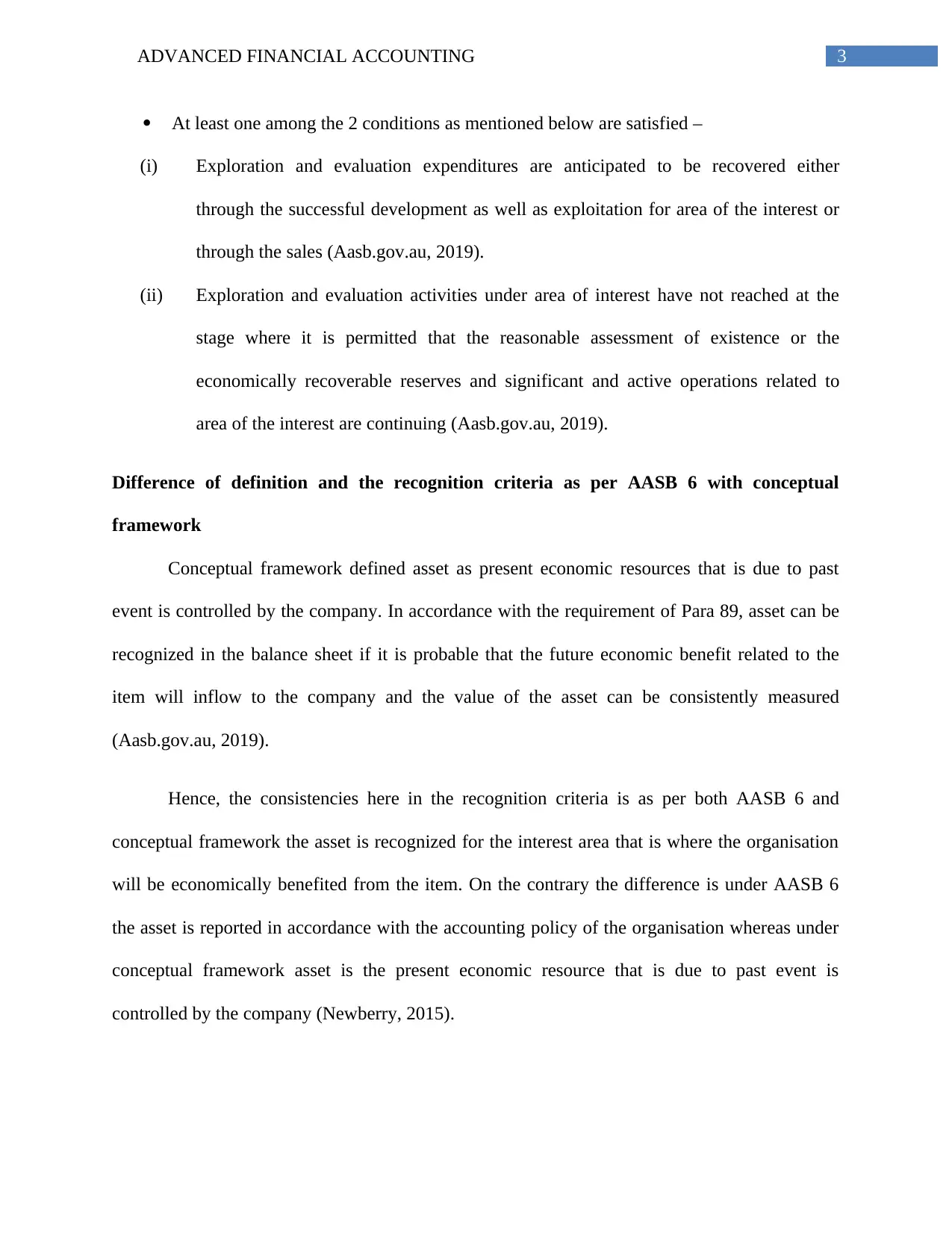
3ADVANCED FINANCIAL ACCOUNTING
At least one among the 2 conditions as mentioned below are satisfied –
(i) Exploration and evaluation expenditures are anticipated to be recovered either
through the successful development as well as exploitation for area of the interest or
through the sales (Aasb.gov.au, 2019).
(ii) Exploration and evaluation activities under area of interest have not reached at the
stage where it is permitted that the reasonable assessment of existence or the
economically recoverable reserves and significant and active operations related to
area of the interest are continuing (Aasb.gov.au, 2019).
Difference of definition and the recognition criteria as per AASB 6 with conceptual
framework
Conceptual framework defined asset as present economic resources that is due to past
event is controlled by the company. In accordance with the requirement of Para 89, asset can be
recognized in the balance sheet if it is probable that the future economic benefit related to the
item will inflow to the company and the value of the asset can be consistently measured
(Aasb.gov.au, 2019).
Hence, the consistencies here in the recognition criteria is as per both AASB 6 and
conceptual framework the asset is recognized for the interest area that is where the organisation
will be economically benefited from the item. On the contrary the difference is under AASB 6
the asset is reported in accordance with the accounting policy of the organisation whereas under
conceptual framework asset is the present economic resource that is due to past event is
controlled by the company (Newberry, 2015).
At least one among the 2 conditions as mentioned below are satisfied –
(i) Exploration and evaluation expenditures are anticipated to be recovered either
through the successful development as well as exploitation for area of the interest or
through the sales (Aasb.gov.au, 2019).
(ii) Exploration and evaluation activities under area of interest have not reached at the
stage where it is permitted that the reasonable assessment of existence or the
economically recoverable reserves and significant and active operations related to
area of the interest are continuing (Aasb.gov.au, 2019).
Difference of definition and the recognition criteria as per AASB 6 with conceptual
framework
Conceptual framework defined asset as present economic resources that is due to past
event is controlled by the company. In accordance with the requirement of Para 89, asset can be
recognized in the balance sheet if it is probable that the future economic benefit related to the
item will inflow to the company and the value of the asset can be consistently measured
(Aasb.gov.au, 2019).
Hence, the consistencies here in the recognition criteria is as per both AASB 6 and
conceptual framework the asset is recognized for the interest area that is where the organisation
will be economically benefited from the item. On the contrary the difference is under AASB 6
the asset is reported in accordance with the accounting policy of the organisation whereas under
conceptual framework asset is the present economic resource that is due to past event is
controlled by the company (Newberry, 2015).
Paraphrase This Document
Need a fresh take? Get an instant paraphrase of this document with our AI Paraphraser
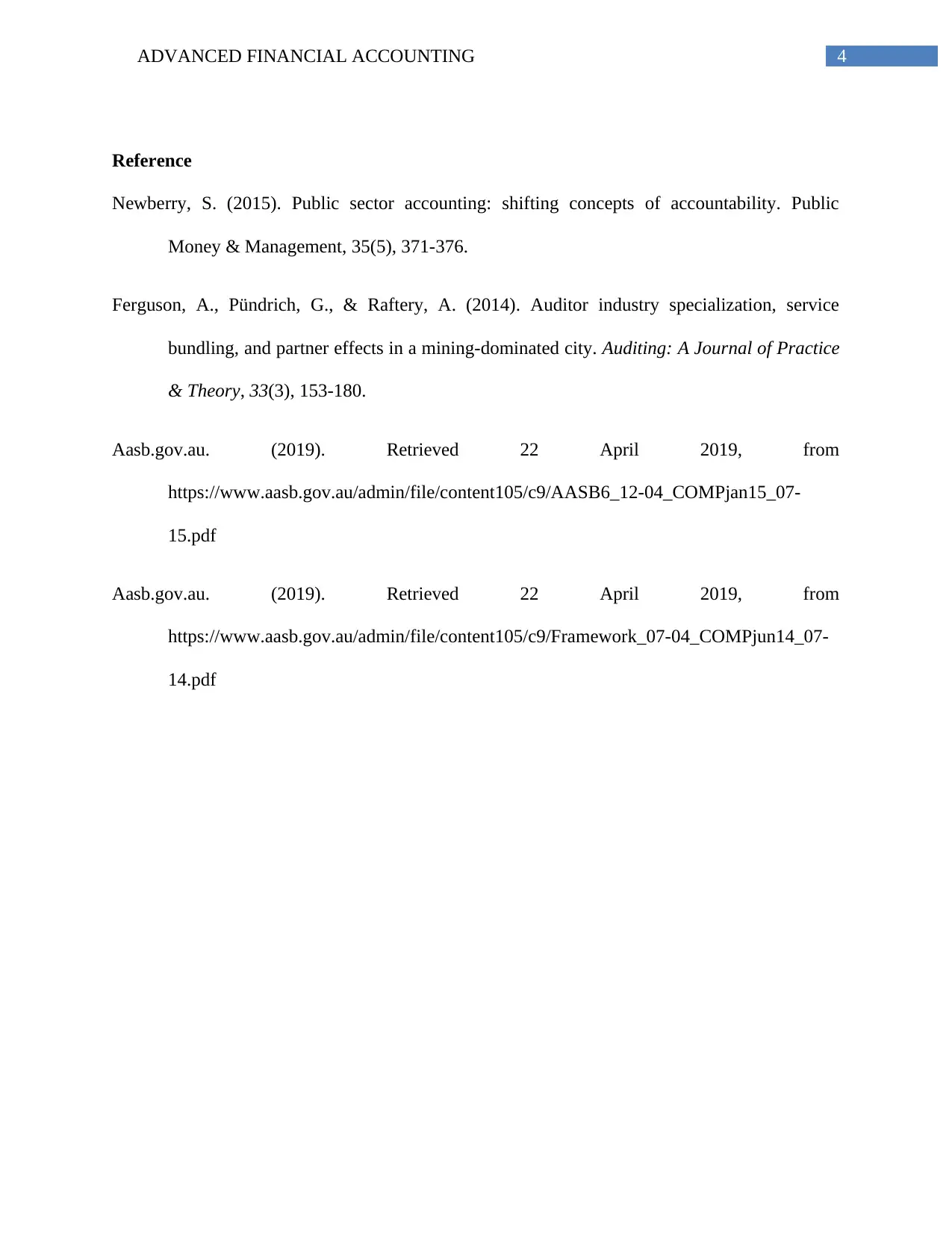
4ADVANCED FINANCIAL ACCOUNTING
Reference
Newberry, S. (2015). Public sector accounting: shifting concepts of accountability. Public
Money & Management, 35(5), 371-376.
Ferguson, A., Pündrich, G., & Raftery, A. (2014). Auditor industry specialization, service
bundling, and partner effects in a mining-dominated city. Auditing: A Journal of Practice
& Theory, 33(3), 153-180.
Aasb.gov.au. (2019). Retrieved 22 April 2019, from
https://www.aasb.gov.au/admin/file/content105/c9/AASB6_12-04_COMPjan15_07-
15.pdf
Aasb.gov.au. (2019). Retrieved 22 April 2019, from
https://www.aasb.gov.au/admin/file/content105/c9/Framework_07-04_COMPjun14_07-
14.pdf
Reference
Newberry, S. (2015). Public sector accounting: shifting concepts of accountability. Public
Money & Management, 35(5), 371-376.
Ferguson, A., Pündrich, G., & Raftery, A. (2014). Auditor industry specialization, service
bundling, and partner effects in a mining-dominated city. Auditing: A Journal of Practice
& Theory, 33(3), 153-180.
Aasb.gov.au. (2019). Retrieved 22 April 2019, from
https://www.aasb.gov.au/admin/file/content105/c9/AASB6_12-04_COMPjan15_07-
15.pdf
Aasb.gov.au. (2019). Retrieved 22 April 2019, from
https://www.aasb.gov.au/admin/file/content105/c9/Framework_07-04_COMPjun14_07-
14.pdf
1 out of 5
Related Documents
Your All-in-One AI-Powered Toolkit for Academic Success.
+13062052269
info@desklib.com
Available 24*7 on WhatsApp / Email
![[object Object]](/_next/static/media/star-bottom.7253800d.svg)
Unlock your academic potential
Copyright © 2020–2025 A2Z Services. All Rights Reserved. Developed and managed by ZUCOL.





